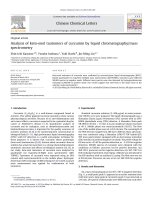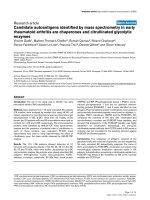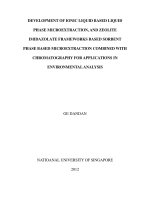Investigation and application of liquid chromatography mass spectrometry in the analysis of polar, less volatile and thermal unstable organic pollutants in environmental and biological samples 6
Bạn đang xem bản rút gọn của tài liệu. Xem và tải ngay bản đầy đủ của tài liệu tại đây (31.48 KB, 3 trang )
6. Chapter Six
Conclusions
The following conclusions were made regarding the optimization of microwave-
assisted extraction techniques for carbamate pesticides, and the application of liquid
chromatography-mass spectrometry for identification and determination of carbamate
pesticides and their related compounds in environmental and biological samples.
Microwave-assisted extraction was applied to study the thermal degradation of five
carbamates (propoxur, thiuram, propham, methiocarb, and chlorpropham) after heating
for 6 min at 95 °C with different extractants. Evidence was presented that significant
thermal degradation of the five targets occurred during extraction and the breakdown
percentage ranged from 10% to 100%, depending on polarities of both analytes and
extractants. The recoveries of carbamates from soil were also dependent on the polarity
of the extractant, and the protection afforded by the soil to the analytes was apparent
when a less polar solvent was used as extractant. Hydrolysis of carbamates occurred in
water under the applied MAE conditions and led to low recoveries when soil moisture
was present. In a comparison of extraction behaviour, it was observed that recoveries of
the pollutants from soil in the extractants considered (methanol, hexane-acetone (1:1),
dichloromethane) were dependent on the relative polarities of the class of analytes:
recoveries increase in the order of increasing analyte polarities (triazines > PCBs >
PAHs).
142
Orthogonal array design was employed to optimize both microwave-assisted extraction
and supercritical fluid extraction conditions for extracting carbamates (propoxur,
propham, methiocarb, and chlorpropham) from spiked soil. An OA
16
(4
4
) matrix derived
from OA
16
(2
15
) was employed to optimize the MAE conditions. The average recovery of
the carbamates was above 94% with good reproducibility under optimum MAE
conditions. SFE was optimized by a two-level OAD procedure. Recoveries of the
analytes from spiked soil by SFE ranged from 87% to 98%, except for propham (66%),
which probably underwent thermal degradation under the extraction conditions. The
results indicate that although carbamates tested in this study are thermally labile, there
was little observable degradation under the optimum MAE and SFE conditions, except
for propham. From the comparison of both methods, it was found that although higher
recoveries were obtained by MAE, recoveries by SFE were good (for propoxur,
methiocarb and chlorpropham) under their respective optimum conditions. Therefore,
both MAE and SFE are suitable techniques for extracting carbamate pesticides from soil.
However, when extraction is from time-aged soil, MAE exhibited better recoveries than
SFE.
Liquid chromatography- atmospheric pressure ionization- ion trap mass spectrometry was
used to investigate the chemical degradation behavior of N-methylcarbamate in
environmental water samples. Propoxur was selected as a model compound to study the
degradation behavior in ultrapure water, drinking water, rain water, river water and
seawater under various pH and irradiation sources (sunlight, darkness, indoor
incandescent lighting and artificial UV lighting). Hydrolysis was found to be very much
143
pH-dependent irrespective of the type of water matrix. Light intensity could prompt
degradation significantly under mild alkaline conditions, while its influence was minor at
higher pH (pH > 9). Furthermore, half-lives and degradation rates were obtained in
various matrix and irradiation sources. Based on kinetic studies, propoxur was found to
degrade more rapidly at higher light exposure and pH.
Furthermore, liquid chromatography- atmospheric pressure chemical ionization- ion trap
mass spectrometry, coupled to microwave-assisted extraction technique, was also been
applied to analyze the residues of N-methylcarbamate and related compounds (propoxur
and its metabolisms as model compounds) in biological materials (goldfish, tortoises and
sea lettuce). Orthogonal array design with an OA
8
(2
7
) matrix was employed to optimize
MAE conditions. It is found that optimized conditions were different in different
biological matrices. The average recoveries of tested compounds in goldfish, tortoises
and algal samples under the respective optimum MAE conditions ranged from 85% to
87% with good reproducibility. The conjugate of 2-isopropoxyphenol occurred in all
tested biological samples under the applied MAE conditions and led to low recoveries.
The stability of propoxur under microwave irradiation was maintained as neither
evaporation losses nor propoxur decomposition was observed during the process. The
extracts of goldfish, tortoises and sea lettuce were stable and a 3-days delay prior to
analysis was possible.
144
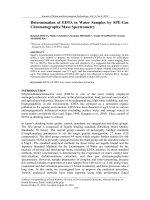
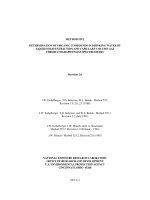
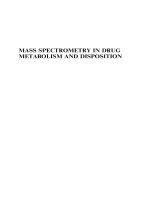
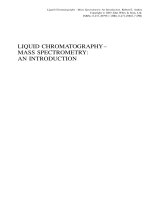
![niessen - liquid chromatography - mass spectrometry 3e [lcms] (crc, 2006)](https://media.store123doc.com/images/document/14/ne/ea/medium_eaq1401870789.jpg)
